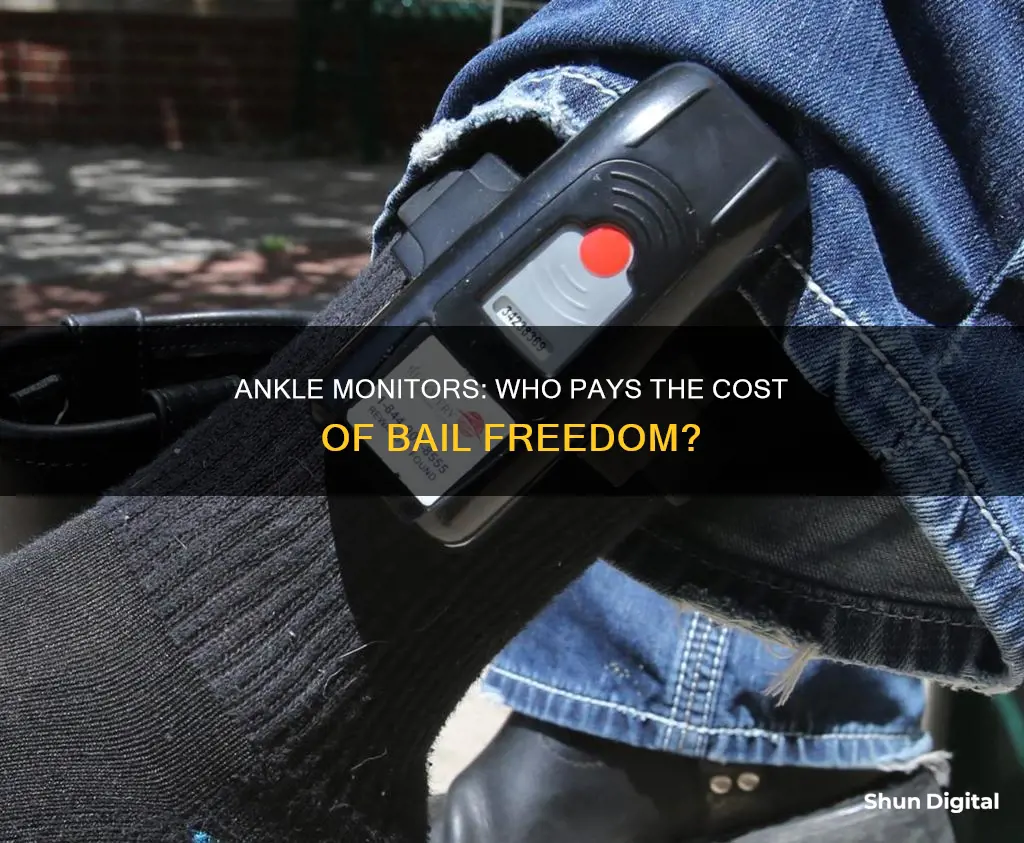
Ankle monitors are often used as a condition of bail, allowing the wearer to remain free while awaiting trial. However, this comes at a cost, with private companies charging defendants hundreds of dollars a month to wear the devices. This has led to concerns that those who cannot afford the fees may end up back in jail. While ankle monitors are promoted as a more humane alternative to incarceration, the associated fees can place a significant financial burden on individuals who are often already facing economic challenges.
| Characteristics | Values |
|---|---|
| Purpose | To ensure the defendant doesn't get into more trouble, to ensure the defendant doesn't flee, and to act as an alternative to a jail sentence |
| Who Pays | The wearer usually has to contribute to the cost of the monitor and a daily use fee |
| Use Cases | House arrest, alcohol monitoring, bail, repeat offenders, domestic violence, DUI or DWI, immigration cases |
| Installation | A company is usually required to install the monitor |
| Cost | Installation fee + daily monitor fee |
| Effectiveness | Easily removable with a pair of scissors |
What You'll Learn

Ankle monitors are used for people on house arrest, bail, or alcohol monitoring
Ankle monitors are often used as a way to ensure people under house arrest or bail remain within the boundaries set by the court. They are also used to monitor alcohol consumption for those convicted of alcohol-related offences.
Ankle monitors are usually about the size of a pager and are strapped to the ankle with a tamper-proof band. They can be used to track an individual's movement and location, and ensure they remain within a certain radius of their home. This is done through radio frequency technology or GPS.
The use of ankle monitors has been a topic of debate, with some critics arguing that they are not effective in rehabilitating individuals and can be restrictive. Others argue that they are a preferable alternative to incarceration, allowing individuals to maintain their jobs, family relationships, and attend rehab programs.
The cost of ankle monitors can vary, with some individuals having to pay between $2 and $20 per day to wear one. This has been a cause for concern, especially for low-income individuals, as the cost can quickly add up. In some jurisdictions, like Baltimore County, Maryland, the cost became a burden during the pandemic, leading to the elimination of ankle monitor fees.
The use of ankle monitors is determined by the court and is based on the situation and nature of the crime committed. They are often used as a condition of bail or parole, or as an alternative to incarceration.
Blind Spot Monitoring: Is It Available on the GR86?
You may want to see also

Ankle monitors are cheaper than prison
Ankle monitors are a more cost-effective alternative to incarceration. They are less expensive than keeping an individual in jail or prison, and they allow individuals to maintain their jobs and support their families. This can make it easier for them to reintegrate into society once their sentences are completed.
The cost of incarceration in the United States has soared, reaching $87 billion in 2015 from $19 billion in 1980. As a result, politicians and criminal justice reformers have advocated for alternatives to reduce incarceration rates and associated costs. Ankle monitors have emerged as a viable option, with over 125,000 people in the criminal justice system being supervised with monitors in 2015, a significant increase from 53,000 in 2005.
Ankle monitors enable individuals to serve their sentences while remaining in the community. They are typically used for individuals on probation or parole or those awaiting trial. Additionally, ankle monitors are an option for low-risk offenders who are not considered a danger to the community. By allowing individuals to continue working, attending school, and caring for their families, ankle monitors provide criminal defense counsel with an extra option.
However, it is important to note that ankle monitors are not without disadvantages. They can be uncomfortable to wear, cause skin irritation, and subject individuals to strict rules and regulations. Any violation of these rules can result in additional penalties or even traditional imprisonment. Therefore, ankle monitors should be used with discretion, considering the offender's risk of reoffending and the nature of the crime.
While ankle monitors offer a cheaper alternative to prison, there are concerns about the financial burden they place on individuals. Private companies often charge defendants hundreds of dollars a month to wear these devices, and failure to pay can result in returning to jail. This has led to criticism that ankle monitors create a system of "digital jail," driving individuals into debt and creating an additional layer of punishment.
In conclusion, ankle monitors are cheaper than prison as they reduce incarceration costs and allow individuals to maintain their livelihoods. However, the financial burden of ankle monitors on individuals and the potential for extended punishment are important considerations in their implementation.
Monitoring Memory Usage on AIX: Key Strategies and Techniques
You may want to see also

The wearer usually has to help pay for the ankle monitor
Ankle monitors are often used as an alternative to jail time for first-time and non-violent offenders. They are also used as a way to reduce bail amounts. The wearer of the ankle monitor usually has to pay for the cost of the device, as well as a daily use fee. These fees can vary depending on the company providing the device and can include installation fees, setup fees, and daily GPS fees.
The cost of an ankle monitor is typically much cheaper than the cost of incarceration, which can be over $20,000 per year. The daily fees for an ankle monitor can range from $5 to $15 per day, plus additional costs for setup and installation. These fees can add up over time, especially if the wearer is required to wear the device for an extended period.
Some court systems charge fees on a sliding scale based on the wearer's income and ability to pay. This takes into account the fact that not everyone can afford the cost of the device and the associated fees. However, if the wearer is unable to pay the fees, they may end up back in jail.
The company providing the ankle monitor will usually require the wearer to contact them and set up an installation. The company will also be responsible for monitoring the device and notifying the relevant authorities if the wearer violates the terms of their release.
Overall, while ankle monitors are presented as a more humane alternative to jail time, the cost of the device and the associated fees can be a significant burden for the wearer, especially if they are already facing financial difficulties.
Monitoring Gas and Electricity Usage: Smart Meter Revolution
You may want to see also

Ankle monitors are used for serious crimes, repeat offenders, and DUIs
Ankle monitors are often used as a condition of bail or parole for people who are considered a danger to the community or a flight risk. They are also used for those who are awaiting trial and deemed likely to commit further crimes if not monitored. Here are some scenarios where ankle monitors are deemed necessary:
Serious Crimes
Serious crimes such as murder, sexual assault, or major drug offences can result in the court ordering the defendant to wear an ankle monitor. This is to ensure that the defendant's movements can be tracked and that they do not violate the conditions set by the court.
Repeat Offenders
For individuals with a history of reoffending, ankle monitors can provide an extra layer of supervision. By tracking their movements, authorities can help prevent them from committing further crimes. This is especially relevant for those who have violated bail or parole terms in the past.
DUIs
In the case of DUI (Driving Under Influence) or DWI (Driving While Intoxicated) offences, ankle monitors can be used as an alternative to pre-trial detention or as a condition of probation. These monitors can detect alcohol levels in the wearer's sweat, ensuring compliance with court orders to refrain from drinking. For those with multiple DUI or DWI convictions, this can be an effective way to enforce sobriety and prevent reoffending.
Setting Up Your ASUS Portable Monitor: A Step-by-Step Guide
You may want to see also

Ankle monitors can be used to reduce bail
Ankle monitors can play a pivotal role in reducing bail amounts for defendants. When an individual is granted bail, they often struggle to pay the high fees involved. Bail bond companies can help offset the cost, but their services usually come at a high price. For instance, if a bail bond company charges a 15% fee and your bail is set at $5000, you will have to pay an additional non-refundable charge of $750.
However, agreeing to wear an ankle monitor can be a way to lower the bail amount. By consenting to this condition, the defendant promises the court that they will remain within a designated area and not attempt to flee. This can increase the chance of getting a lower bail price or even no bail at all. For example, if the bail amount is reduced from $5000 to $2500 due to the use of an ankle monitor, the defendant would only owe the bail bond company $250 if their fee is 10%. The daily GPS fees for the monitor would take months to accumulate to the original bail amount.
The use of an ankle monitor also reassures the court system that the defendant does not pose a flight risk. In cases where an individual is considered a flight risk, a judge may be inclined to deny bail altogether. A lawyer can recommend bail with the contingency of an ankle monitor, which provides 24-hour GPS tracking and reduces the likelihood of the defendant absconding.
Furthermore, ankle monitors allow individuals to quickly return to work and continue earning an income to pay their bail bond and GPS fees. While wearing an ankle monitor may come with challenges, such as privacy concerns and stigma, it offers the benefit of living at home and maintaining employment during the legal proceedings.
Overall, ankle monitors can be a valuable tool in reducing bail amounts, providing an additional layer of security and compliance for the court system, and allowing defendants to retain their freedom while awaiting trial.
Maximizing Your Hyper-V Experience: Monitor Size and Beyond
You may want to see also
Frequently asked questions
Yes, the wearer usually has to pay for the cost of the monitor and a daily use fee. The daily fee can vary from $5 to $15 per day, plus a setup fee that can be as high as $200.
Ankle monitors are devices strapped to your ankle that track your movement and location. They are usually about the size of a pager and use GPS to determine your whereabouts. If you go outside a designated area, the device vibrates and emits a loud tone.
Agreeing to wear an ankle monitor can help lower your bail amount. It reassures the court that you are not a flight risk and can result in a monitored situation for the duration of your court case.
Ankle monitors can be uncomfortable and restrictive. They can also be expensive, with private companies charging defendants hundreds of dollars a month to wear them. If people can't pay, they may end up back in jail.







